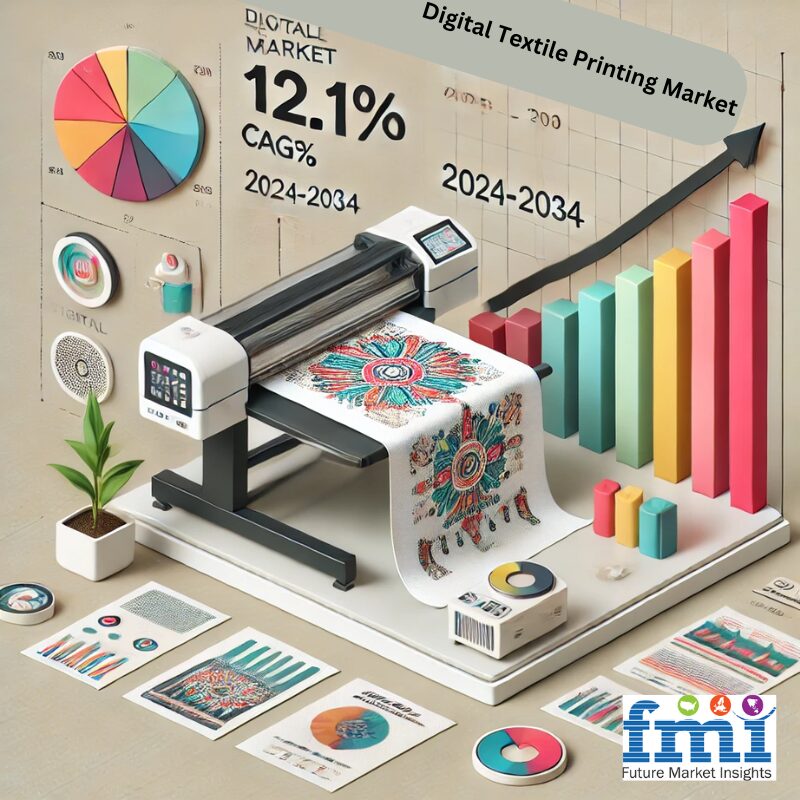 The digital textile printing market is experiencing significant growth owing to the technology’s ability to offer precise, high-quality prints with vibrant colors and intricate designs for industries like fashion, home decor, and advertising. Unlike traditional printing methods, digital textile printing allows for greater customization and flexibility, meeting the increasing consumer demand for unique and personalized products.
The digital textile printing market is experiencing significant growth owing to the technology’s ability to offer precise, high-quality prints with vibrant colors and intricate designs for industries like fashion, home decor, and advertising. Unlike traditional printing methods, digital textile printing allows for greater customization and flexibility, meeting the increasing consumer demand for unique and personalized products.
According to Future Market Insights (FMI), the global digital textile printing market is set to experience substantial growth over the forecast period, with a projected compound annual growth rate (CAGR) of 12.1% from 2024 to 2034. This remarkable growth is expected to drive the market from USD 2,989.6 million in 2024 to a forecasted USD 8,897.3 million by 2034, indicating strong demand for advanced printing technologies in the textile industry.?
Digital textile printing has revolutionized the textile and fashion industries by offering increased flexibility, superior quality, and environmentally sustainable solutions. This technology allows for direct printing on fabric using digital designs, making it an essential tool for manufacturers seeking to cater to the growing consumer demand for customized, sustainable, and quick-to-market products.
As the fashion, home décor, and advertising industries increasingly adopt digital textile printing, the market is expected to witness steady growth across various regions, particularly in North America, Europe, and Asia Pacific. These regions are home to key industry players and continue to invest in sustainable technologies, further driving demand.
Growth Drivers and Opportunities
Several factors are contributing to the growth of the digital textile printing industry. A key driver is the rising consumer demand for personalized and customized textile products, which digital printing easily facilitates. Unlike traditional printing methods, digital textile printing allows for shorter print runs and faster turnaround times, meeting the needs of today’s fast-paced market.
Another growth driver is the industry’s increasing focus on sustainability. Digital textile printing produces significantly less waste compared to conventional methods, uses less water, and reduces the need for excess inventory. As sustainability becomes a priority for both consumers and manufacturers, digital textile printing emerges as an attractive solution.
Technological advancements in digital printing equipment, inks, and software are also creating new opportunities. These innovations are improving print quality, durability, and efficiency, enabling manufacturers to expand their product offerings and cater to a wider range of industries, from fashion and home décor to signage and banners.
“The rise in demand for personalized products is driving the adoption of digital textile printing, enabling on-demand production of custom designs. This flexibility allows fashion designers to explore intricate patterns and colors, overcoming the limitations of traditional printing methods,” Says a Lead Consultant Ismail Sutaria at Future Market Insights (FMI).
Key Takeaways from the Market Study
• The global Digital Textile Printing Market is projected to grow from USD 2,989.6 million in 2024 to USD 8,897.3 million in 2034.
• The market is expected to register a robust CAGR of 12.1% during the forecast period (2024 to 2034).
• Increased demand for sustainable and customizable textile solutions is a primary growth driver.
• North America, Europe, and Asia Pacific are key regional markets due to strong industrial adoption of digital printing technology.
Component Insights
The digital textile printing market can be segmented into various components, including digital textile printers, inks, and software. Digital textile printers hold the largest share of the market, driven by demand from industries such as fashion, home textiles, and advertising. These printers are increasingly preferred due to their efficiency, high-quality output, and versatility across different fabrics.
Ink technology also plays a crucial role in the growth of the market, with pigment inks and sublimation inks gaining traction for their vibrant color output and durability. These inks are designed to work seamlessly with digital printers, providing a superior finish and longer-lasting results compared to traditional dyes.
Market’s Prime Determinants of Growth, Trends, and Opportunities
Several key trends and determinants are shaping the future of the digital textile printing market. The growing awareness of environmental issues is pushing manufacturers toward eco-friendly solutions, with digital printing emerging as a low-impact alternative to traditional textile printing methods. This shift is expected to accelerate as governments and regulatory bodies introduce stricter environmental standards for the textile industry.
Customization and personalization are major trends driving market growth. As consumers seek unique, tailor-made products, digital textile printing allows for one-off designs and small-batch production, providing businesses with a competitive edge in meeting customer demands.
Furthermore, the rise of fast fashion has significantly impacted the demand for digital textile printing, as brands require quicker production cycles to keep up with evolving trends. Digital printing’s ability to produce designs on-demand with minimal setup time has made it the technology of choice for many fashion brands.
Key Companies & Market Share Insights
The Digital Textile Printing Market is highly competitive, with key players continually innovating to maintain their market positions. These companies are focusing on expanding their product portfolios, investing in research and development, and forging strategic partnerships to strengthen their market presence. With the demand for digital textile printing continuing to rise, industry leaders are well-positioned to capitalize on the growing trend towards sustainable and customized printing solutions.
















